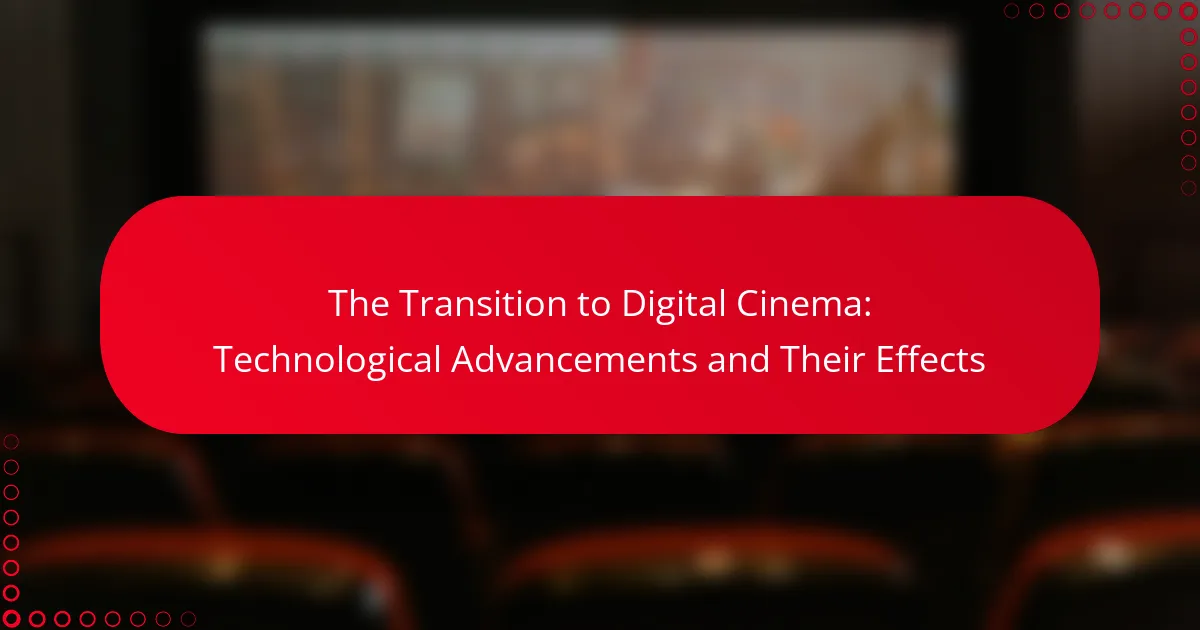The transition to digital cinema marks a significant shift from traditional film projection to digital technology in filmmaking and exhibition, beginning in the late 1990s and accelerating in the 2000s. This transformation has been driven by advancements in digital projectors, cameras, and editing software, resulting in improved image quality, reduced production costs, and enhanced creative opportunities for filmmakers. By 2012, over 80% of theaters in the United States had adopted digital projection, leading to a more efficient distribution process and an enriched viewing experience for audiences. The prevalence of digital formats has facilitated the global distribution of films, allowing independent filmmakers to reach wider audiences and contributing to the current landscape where 95% of films are distributed digitally.

What is the Transition to Digital Cinema?
The transition to digital cinema refers to the shift from traditional film projection to digital technology in filmmaking and exhibition. This transition began in the late 1990s and gained momentum in the 2000s. Digital cinema utilizes digital projectors and cameras to capture and display films. The technology offers advantages such as improved image quality and easier distribution. By 2012, over 80% of theaters in the United States had converted to digital projection. This change has also reduced production costs and enhanced the creative possibilities for filmmakers.
How has the evolution of cinema technology influenced this transition?
The evolution of cinema technology has significantly influenced the transition to digital cinema. Traditional film formats have gradually been replaced by digital formats. This shift has improved image quality and accessibility. Digital projection allows for greater consistency in viewing experiences. The rise of high-definition and 4K resolutions enhances visual clarity. Digital editing software has streamlined post-production processes. Additionally, advancements in storage technology facilitate easier distribution of films. According to the Motion Picture Association, over 90% of theaters worldwide now use digital projection systems. This transition has transformed audience engagement and film production methods.
What are the key milestones in the transition from film to digital?
The key milestones in the transition from film to digital include the introduction of digital cinematography in the late 1990s. In 1999, the Sony HDW-F900 became the first digital camera used for a major motion picture, “Star Wars: Episode II – Attack of the Clones.” The year 2002 saw the release of the first fully digital feature film, “The Last Starfighter.”
In 2005, the first digital projection system was installed in a commercial cinema. By 2012, digital cinema surpassed film in the number of screens worldwide. The transition was accelerated by the development of high-definition formats and the increasing affordability of digital cameras.
By 2013, major film festivals began accepting digital submissions exclusively. The final key milestone occurred in 2019 when the last major film studio ceased 35mm film production, marking a definitive end to traditional film. These milestones highlight the technological advancements that facilitated the shift from film to digital cinema.
How do technological advancements define the digital cinema landscape?
Technological advancements define the digital cinema landscape by enabling higher quality visuals and sound. Innovations like 4K resolution and HDR enhance image clarity and color depth. Digital sound systems, such as Dolby Atmos, provide immersive audio experiences. The use of digital projectors has replaced traditional film projectors, streamlining the distribution process. Online streaming platforms have transformed how audiences access films. These advancements facilitate real-time editing and special effects, increasing production efficiency. According to the Motion Picture Association, digital cinema now accounts for over 90% of global box office revenue. This shift reflects the industry’s adaptation to new technologies and consumer preferences.
What are the primary factors driving the transition to digital cinema?
The primary factors driving the transition to digital cinema include technological advancements, cost efficiency, and enhanced viewing experiences. Technological advancements have led to improved image quality and sound. Digital projectors offer higher resolution compared to traditional film projectors. Cost efficiency is evident in reduced distribution and storage costs for digital films. Filmmakers benefit from easier editing and post-production processes with digital formats. Enhanced viewing experiences come from features like 3D and immersive audio. According to a report by the Digital Cinema Initiatives (DCI), over 90% of theaters in the U.S. have transitioned to digital projection. This shift has significantly influenced audience engagement and accessibility.
How do consumer preferences impact the shift to digital formats?
Consumer preferences significantly drive the shift to digital formats. Increased demand for convenience influences this transition. Consumers prefer easy access to content on various devices. This preference has led to the rise of streaming services. Studies show that 82% of consumers prefer digital formats for their accessibility. Additionally, younger audiences gravitate towards digital media over traditional formats. This demographic shift accelerates the industry’s adaptation to digital technologies. As a result, content providers are investing more in digital distribution. The trend indicates a clear consumer-led movement towards digital cinema.
What role do production costs play in the transition?
Production costs significantly influence the transition to digital cinema. Lower production costs associated with digital technology facilitate broader adoption. Digital cameras and editing software typically reduce expenses compared to traditional film methods. For example, the cost of shooting a feature film on digital formats can be up to 30% less than using film. This cost-effectiveness encourages filmmakers to adopt digital practices. Additionally, reduced costs in distribution and exhibition further promote the transition. Digital cinema allows for easier distribution and lower marketing expenses, enhancing profitability for studios. Overall, production costs are a critical factor in driving the shift towards digital cinema.

What technological advancements have facilitated the transition to digital cinema?
Digital cinema has been facilitated by several technological advancements. High-definition digital projection systems replaced traditional film projectors. These systems provide clearer images and reduce maintenance costs. Digital cameras have improved in resolution and affordability. They allow filmmakers to capture high-quality footage without film stock. Advanced editing software has streamlined the post-production process. This software enables faster editing and effects integration. Digital distribution methods have also emerged. These methods allow for quicker and more efficient delivery of films to theaters. Overall, these advancements have transformed the filmmaking and viewing experience.
How has digital projection technology evolved over time?
Digital projection technology has evolved significantly since its inception. Initially, film projectors dominated the cinema landscape. The transition to digital began in the late 1990s with the introduction of digital cinema projectors. Early models had lower resolutions, typically around 2K.
As technology advanced, 4K projectors became standard, offering sharper images. The introduction of laser projection further enhanced brightness and color accuracy. Digital projectors now support 3D and high dynamic range (HDR) content, providing immersive viewing experiences.
The industry saw widespread adoption of digital projection by the mid-2000s, largely due to cost reductions and improved technology. By 2012, over 90% of theaters in the U.S. had converted to digital systems. This evolution has transformed how films are produced, distributed, and exhibited, leading to a more streamlined process.
What are the benefits of digital projection compared to traditional film projection?
Digital projection offers several benefits over traditional film projection. Firstly, digital projection provides superior image quality. It delivers sharper images with higher resolution and better color accuracy. Secondly, it eliminates film degradation issues. Unlike film, digital formats do not suffer from scratches or fading over time. Thirdly, digital projection allows for easier distribution and storage. Digital files can be transmitted quickly and stored compactly. Additionally, it enables more flexibility in editing and special effects. Digital projection also supports a wider range of formats and aspect ratios. Lastly, it often reduces operational costs in the long run. These advantages contribute to the growing preference for digital projection in cinemas.
What types of digital projectors are commonly used in cinemas?
The types of digital projectors commonly used in cinemas include DLP (Digital Light Processing) and LCoS (Liquid Crystal on Silicon) projectors. DLP projectors utilize a digital micromirror device to create images. They are known for their brightness and reliability. LCoS projectors, on the other hand, use liquid crystals and are praised for their superior color accuracy. Both types support high-definition resolutions, which are essential for modern cinema experiences. According to the Digital Cinema Initiatives (DCI), these projectors meet industry standards for digital cinema projection. This ensures a consistent and high-quality viewing experience across various cinema venues.
What innovations in sound technology have emerged with digital cinema?
Digital cinema has introduced several key innovations in sound technology. One major advancement is the use of immersive audio formats, such as Dolby Atmos. This technology enables sound to move in a three-dimensional space, creating a more engaging experience for the audience.
Another significant innovation is the transition from analog to digital soundtracks. Digital soundtracks provide higher fidelity and clarity compared to their analog counterparts. This change enhances the overall audio quality in films.
Additionally, advancements in sound mixing software have improved the precision of audio editing. Tools like Pro Tools allow sound designers to manipulate and layer audio tracks more effectively.
Furthermore, the integration of sound design with visual effects has become more seamless. This synergy allows for a more cohesive storytelling experience.
These innovations collectively enhance the cinematic experience, making sound an integral part of modern filmmaking.
How do digital sound systems enhance the movie-watching experience?
Digital sound systems significantly enhance the movie-watching experience by providing immersive audio quality. These systems utilize advanced sound technologies, such as surround sound and spatial audio. This creates a more realistic and engaging environment for viewers. Surround sound systems can replicate sounds from multiple directions. This allows audiences to feel as if they are part of the action.
Digital sound systems also offer clarity and precision in audio playback. This ensures that dialogue, sound effects, and music are delivered with high fidelity. According to a study by the Motion Picture Association, films with enhanced audio experience higher audience satisfaction ratings. Enhanced audio can increase emotional engagement with the film. Overall, digital sound systems transform how viewers perceive and interact with cinematic content.
What are the latest trends in audio technology for digital films?
The latest trends in audio technology for digital films include immersive sound formats, spatial audio, and enhanced audio editing software. Immersive sound formats, such as Dolby Atmos, allow filmmakers to create a three-dimensional sound experience. Spatial audio technology enables sound to move in a three-dimensional space, improving viewer engagement. Enhanced audio editing software, like Pro Tools and Adobe Audition, provides advanced features for precise sound manipulation. Additionally, AI-driven audio tools are emerging, assisting in sound design and mixing. These trends reflect the industry’s shift towards creating more engaging and realistic audio experiences in digital cinema.

What effects has the transition to digital cinema had on the film industry?
The transition to digital cinema has significantly transformed the film industry. It has reduced production and distribution costs. Digital formats allow for easier editing and post-production processes. Filmmakers can now utilize high-quality digital cameras, enhancing visual storytelling. Digital cinema also enables global distribution through online platforms. The audience’s viewing experience has improved with better sound and picture quality. According to the Motion Picture Association, 95% of films are now distributed digitally. This shift has led to an increase in independent films reaching wider audiences.
How has digital cinema impacted film production and distribution?
Digital cinema has revolutionized film production and distribution. It has significantly reduced production costs. Filmmakers can now use digital cameras which are less expensive than traditional film equipment. This accessibility has democratized filmmaking, allowing more creators to enter the industry.
Digital editing software has streamlined the post-production process. Editing is now faster and more efficient compared to traditional methods. Additionally, digital cinema allows for easier distribution. Films can be distributed online, reaching global audiences without the need for physical copies.
Statistics show that over 90% of films are now released digitally. This shift has transformed how audiences consume films, with streaming services becoming dominant. Overall, digital cinema has made film production more accessible and distribution more efficient.
What changes have occurred in the filmmaking process due to digital technology?
Digital technology has significantly transformed the filmmaking process. Filmmakers can now capture high-quality footage using digital cameras, which are more affordable and accessible than traditional film cameras. This shift has reduced production costs and increased the speed of shooting. Editing has also become more efficient with digital editing software, allowing for quicker turnaround times.
Additionally, digital technology enables filmmakers to use visual effects more seamlessly. Computer-generated imagery (CGI) can be integrated into live-action footage with ease. This has expanded creative possibilities and enhanced storytelling.
Moreover, digital distribution has changed how films reach audiences. Streaming platforms allow for immediate access to films, bypassing traditional distribution channels. This has democratized film viewing and increased audience reach.
In summary, digital technology has made filmmaking more cost-effective, efficient, and accessible while enhancing creative opportunities and distribution methods.
How has the distribution model for films changed with digital cinema?
The distribution model for films has significantly changed with digital cinema. Traditional film distribution relied on physical prints and theatrical releases. Digital cinema allows for immediate distribution through digital files. This transition reduces costs associated with printing and shipping physical media. Streaming services have become a primary platform for distribution. They provide instant access to films worldwide. This shift has led to a rise in direct-to-consumer models. Filmmakers can now reach audiences without traditional intermediaries. According to the MPAA, streaming services accounted for 80% of the film market in 2021. This demonstrates the profound impact of digital cinema on film distribution.
What are the implications of digital cinema for audiences and filmmakers?
Digital cinema significantly impacts both audiences and filmmakers. For audiences, it enhances accessibility and viewing experiences. Digital formats allow for higher resolution and improved sound quality. This leads to a more immersive experience in theaters and at home. Filmmakers benefit from reduced production costs and increased creative flexibility. Digital tools facilitate easier editing and special effects integration. Moreover, distribution becomes more efficient through digital platforms. These changes have transformed how films are marketed and consumed. Overall, digital cinema fosters a more dynamic relationship between audiences and filmmakers.
How does digital cinema affect audience engagement and experience?
Digital cinema significantly enhances audience engagement and experience. It provides higher image quality and sound clarity. These improvements create a more immersive viewing environment. Enhanced visual effects and 3D presentations captivate audiences. Digital projection eliminates issues like film grain and flicker. This clarity helps audiences focus on the storytelling. Additionally, digital cinema allows for interactive experiences, such as audience participation. Research indicates that immersive technologies increase emotional responses in viewers. Overall, digital cinema transforms how audiences connect with films.
What challenges do filmmakers face in the digital landscape?
Filmmakers face several challenges in the digital landscape. One major challenge is the overwhelming amount of content available. With millions of videos online, standing out becomes difficult. Another challenge is the rapid evolution of technology. Filmmakers must continuously adapt to new tools and software. This can require significant investment in training and equipment. Additionally, distribution has changed dramatically. Traditional pathways are less effective, leading to increased competition for audience attention. Filmmakers also struggle with funding in a digital environment. Crowdfunding and digital platforms can be unpredictable sources of financial support. Lastly, issues of piracy and copyright protection are prevalent. Digital content is easily copied and shared, undermining revenue streams. These challenges require filmmakers to innovate and adapt to succeed.
What best practices should filmmakers adopt in the digital cinema era?
Filmmakers should adopt several best practices in the digital cinema era. First, they should embrace digital tools for production and post-production. Digital cameras offer high-resolution options and flexibility in shooting. Filmmakers can also utilize editing software for efficient post-production workflows. Collaboration through cloud-based platforms enhances teamwork and communication. Additionally, filmmakers should focus on understanding digital distribution channels. This includes streaming services that have become predominant. Engaging with audiences on social media can also enhance marketing efforts. Lastly, keeping abreast of technological advancements is crucial for staying competitive. Adopting these practices can lead to improved storytelling and increased audience engagement.
The main entity of the article is the transition to digital cinema, which encompasses the shift from traditional film projection to digital technology in filmmaking and exhibition. The article provides an overview of the technological advancements that have facilitated this transition, highlighting key milestones, the evolution of cinema technology, and the impact on production and distribution processes. It discusses the benefits of digital projection, including improved image quality, cost efficiency, and enhanced audience engagement, while also addressing the challenges filmmakers face in the digital landscape. Additionally, the article outlines best practices for filmmakers to adapt to the digital cinema era effectively.
